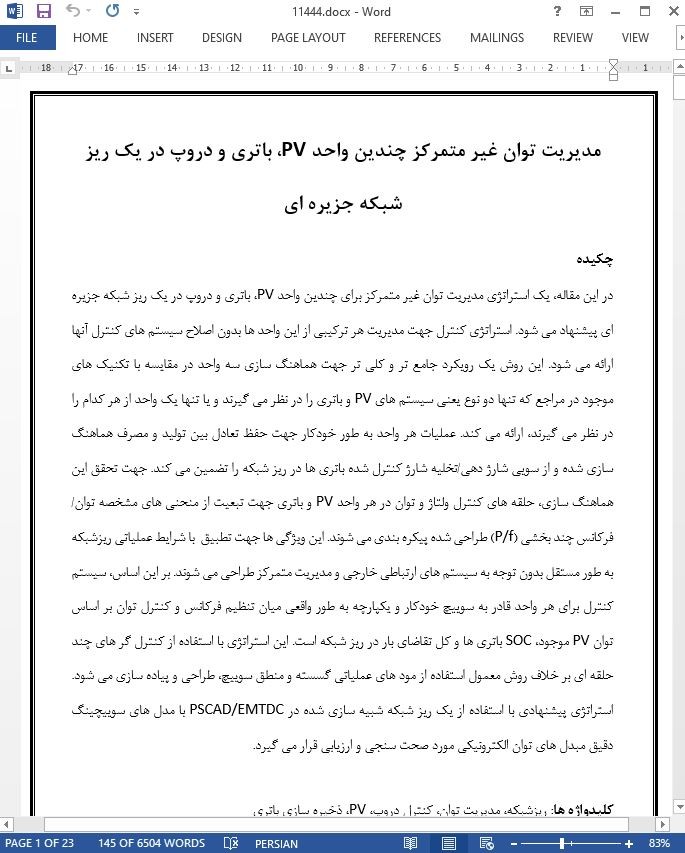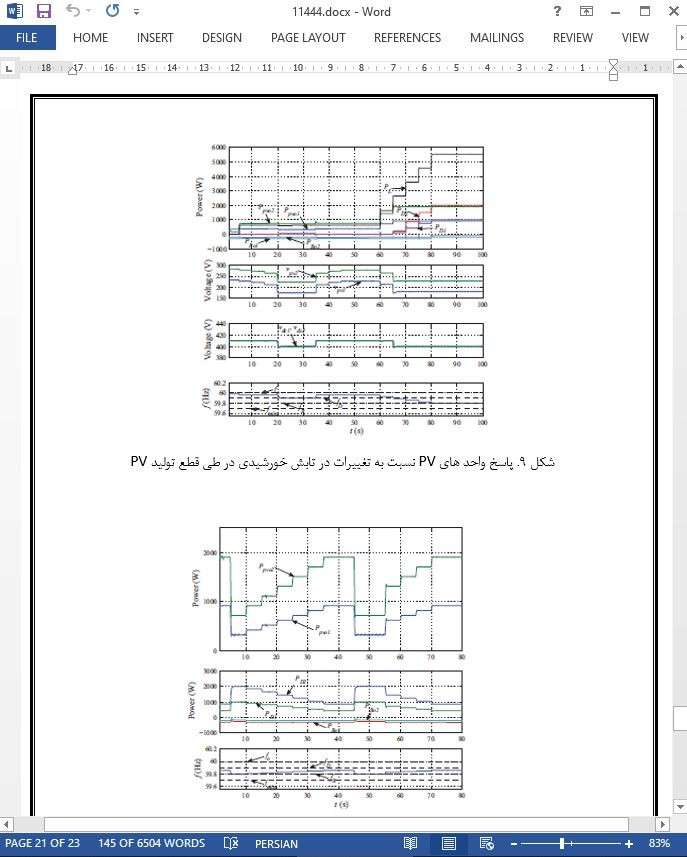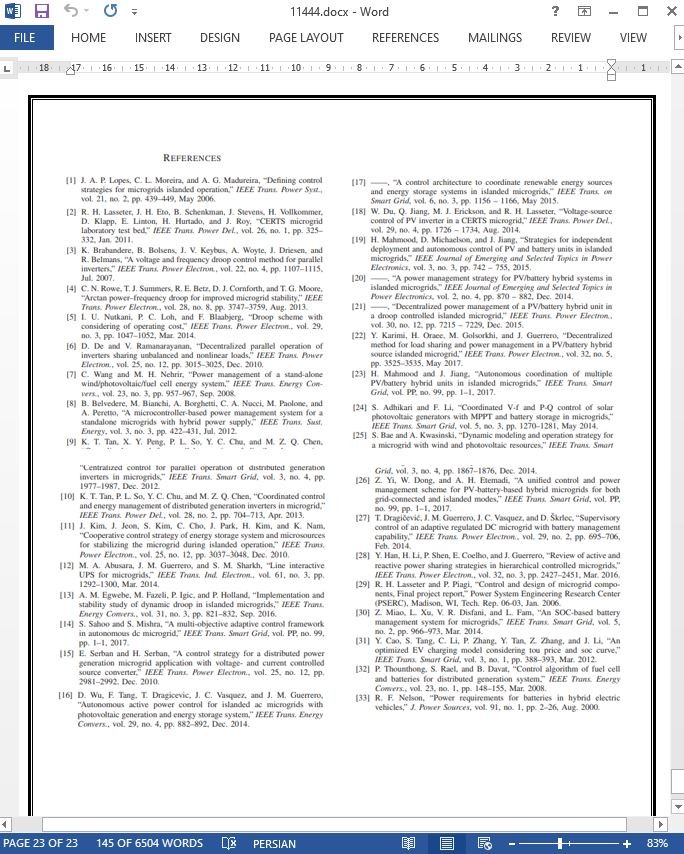
مدیریت توان غیر متمرکز چندین واحد PV، باتری و دروپ در یک ریز شبکه جزیره ای
چکیده
در این مقاله، یک استراتژی مدیریت توان غیر متمرکز برای چندین واحد PV، باتری و دروپ در یک ریز شبکه جزیره ای پیشنهاد می شود. استراتژی کنترل جهت مدیریت هر ترکیبی از این واحد ها بدون اصلاح سیستم های کنترل آنها ارائه می شود. این روش یک رویکرد جامع تر و کلی تر جهت هماهنگ سازی سه واحد در مقایسه با تکنیک های موجود در مراجع که تنها دو نوع یعنی سیستم های PV و باتری را در نظر می گیرند و یا تنها یک واحد از هر کدام را در نظر می گیرند، ارائه می کند. عملیات هر واحد به طور خودکار جهت حفظ تعادل بین تولید و مصرف هماهنگ سازی شده و از سویی شارژ دهی/تخلیه شارژ کنترل شده باتری ها در ریز شبکه را تضمین می کند. جهت تحقق این هماهنگ سازی، حلقه های کنترل ولتاژ و توان در هر واحد PV و باتری جهت تبعیت از منحنی های مشخصه توان/ فرکانس چند بخشی (P/f) طراحی شده پیکره بندی می شوند. این ویژگی ها جهت تطبیق با شرایط عملیاتی ریزشبکه به طور مستقل بدون توجه به سیستم های ارتباطی خارجی و مدیریت متمرکز طراحی می شوند. بر این اساس، سیستم کنترل برای هر واحد قادر به سوییچ خودکار و یکپارچه به طور واقعی میان تنظیم فرکانس و کنترل توان بر اساس توان PV موجود، SOC باتری ها و کل تقاضای بار در ریز شبکه است. این استراتژی با استفاده از کنترل گر های چند حلقه ای بر خلاف روش معمول استفاده از مود های عملیاتی گسسته و منطق سوییچ، طراحی و پیاده سازی می شود. استراتژی پیشنهادی با استفاده از یک ریز شبکه شبیه سازی شده در PSCAD/EMTDC با مدل های سوییچینگ دقیق مبدل های توان الکترونیکی مورد صحت سنجی و ارزیابی قرار می گیرد.
1. مقدمه
ماهیت متناوب تولید توان فتوولتیک (PV) موجب ایجاد یک چالش بزرگ جهت به کارگیری قابل توجه سیستم های PV در ریز شبکه های جزیره ای می شود. این موضوع نیازمند استفاده از سیستم های باتری جهت تکمیل تولید متناوب واحد های PV به منظور حفظ تعادل توان در ریزشبکه های جزیره ای است. به عبارت دیگر، سیستم های باتری نشان دهنده نقش کارای شبکه در ریز شبکه های متصل شده به شبکه جهت تامین/جذب انرژی مازاد/ مورد نیاز است. با این حال، سیستم های باتری دارای میزان توانا محدود، ظرفیت محدود و شارژ دهی محدود بوده که وابسته به وضعیت شارژ دهی باتری (SOC) هستند. بنابراین، باید عملیات PV و واحد های باتری جهت در نظر گرفتن تولید PV متناوب و محدودیت های عملیاتی واحد های باتری سازمان دهی می شوند. علاوه براین، واحد های PV و باتری باید قادر به هماهنگ سازی با واحد های غیر قابل توزیع که به طور معمول جهت تضمین یکپارچگی تامین مورد استفاده قرار می گیرند، باشند. در ریزشبکه های جزیره ای، این واحد ها از استراتژی های کنترل دروپ جهت تحقق به اشتراک گذاری توان در میان واحد ها استفاده می کنند.
4- نتیجه گیری
در این تحقیق یک استراتژی مدیریت توان غیر متمرکز جهت هماهنگ سازی PV، باتری و واحد های دروپ در ریزشبکه های جزیره ای ارائه شده است. در این استراتژی ولتاژ محلی و حلقه های کنترل توان در هر کدام از واحد های PV و باتری جهت تبعیت از منحنی های مشخصه P/f چند بخشی پیکربندی می شوند. این منحنی ها به طور همزمان در هر واحد و در هر واحد نسبت به شرایط عملیاتی ریزشبکه عمل می کنند. نشان داده شد که با استفاده از این منحنی های P/f، یک هماهنگ سازی کامل بدون توجه به هر گونه ارتباطات خارجی و روش های مدیریت مرکزی قابل حصول است. همچنین اجرای کنترل چند حلقه ای استراتژی منجر به تغییرات یکنواحت در میان اهداف کنترلی مختلف می شود. عملکرد استراتژی پیشنهادی با استفاده از یک مدل سوییچینگ اجرا شهد در محیط psca/ad/emtdc اجرا شد.
Abstract
In this paper, a decentralized power management strategy is proposed for multiple photovoltaic (PV), battery, and droop units in an islanded microgrid. The control strategy is developed to handle any combination of these units without modifying their control systems. This provides a more comprehensive and generalized approach to coordinate the three types of units, in comparison to the techniques in the literature that consider only two types, mainly PV and battery systems, or consider only a single unit of each type. The operation of each unit is autonomously coordinated to maintain the balance between generation and consumption, while ensuring controlled charging/discharging of the batteries in the microgrid. To achieve this coordination, the voltage and the power control loops, within each of the PV and battery units, are configured to follow the specifically designed multi-segment power/frequency (P/f) characteristic curves. These characteristics are designed to independently adapt to the microgrid operating conditions, without relying on any external communications and centralized management systems. Accordingly, the control system for each unit is able to autonomously and seamlessly switch in real-time between power control and frequency regulation based on the available PV power, the state-of-charge of the batteries, and the total load demand in the microgrid. The strategy is designed and implemented using multi-loop controllers, in contrast to the commonly adopted approach of using discrete operating modes and switching logics. The proposed strategy is validated using a microgrid simulated in PSCAD/EMTDC with detailed switching models of the power electronic converters.
I. INTRODUCTION
THE intermittent nature of photovoltaic (PV) power generation poses a great challenge to the widespread adoption of PV systems in islanded microgrids. This necessitates the deployment of battery systems to complement the intermittent generation of PV units in order to maintain power balance in islanded microgrids. In other words, battery systems mimic the role the utility grid plays in grid-connected microgrids, to supply/absorb needed/surplus energy. However, battery systems have limited power ratings, limited capacities, and restricted charging scenarios that depend on the battery state-of-charge (SOC). Therefore, the operation of the PV and battery units must be coordinated to consider both the intermittent PV generation and the operating constraints of the battery units. Moreover, PV and battery units must be able to coordinate with dispatchable units that are commonly deployed to ensure continuity of supply. In islanded microgrids, these units typically employ the droop control strategies to achieve appropriate power sharing among the units [1]–[6].
IV. CONCLUSION
A decentralized power management strategy is developed in this paper to coordinate PV, battery, and droop controlled units in islanded microgrids. In this strategy, the local voltage and power control loops, at each of the PV and battery units, are configured to follow multi-segment P/f characteristic curves. These characteristic curves can be adjusted autonomously at each unit according to the microgrid operating conditions. It is shown that by using these adaptive P/f characteristic curves, a fully autonomous coordination can be achieved, without relying on any external communications and central management schemes. Also, it is shown that the multi-loop control implementation of the strategy results in smooth transitions among different control objectives. The performance of the proposed strategy has been successfully validated using a detailed switching model implemented in the PSCAD/EMTDC environment.
چکیده
1. مقدمه
2. استراتژی کنترلی پیشنهادی
A. اهداف کنترلی
B. اقدامات کنترل و عملیات اصلی
C. تغییرات پاسخ در تولید توان PV
D. پاسخ به تغییرات SOC
3. صحت سنجی
A. عملیات اصلی
B. عملکرد شارژ شدن باتری
C. قطع تولید PV
4. نتیجه گیری
Abstract
I. INTRODUCTION
II. PROPOSED CONTROL STRATEGY
A. Control Objectives
B. Basic Operation and Control Actions
C. Response Changes in PV Power Production
D. Response to SOC Variations
III. VALIDATION
A. Basic Operation
B. Battery Charging Performance
C. PV Generation Curtailment
IV. CONCLUSION
- ترجمه فارسی مقاله با فرمت ورد (word) با قابلیت ویرایش، بدون آرم سایت ای ترجمه
- ترجمه فارسی مقاله با فرمت pdf، بدون آرم سایت ای ترجمه



